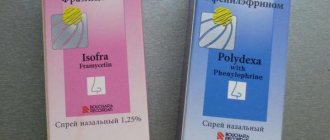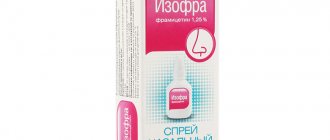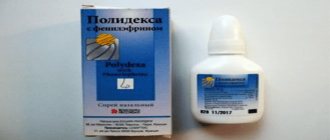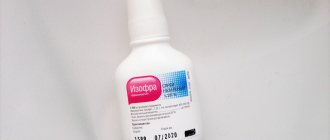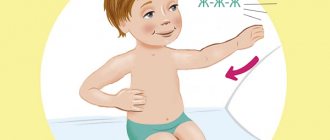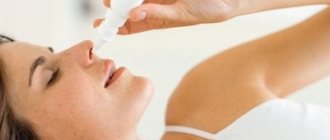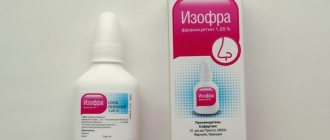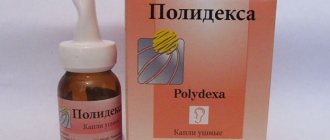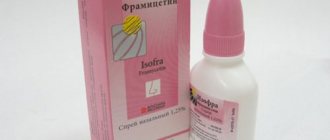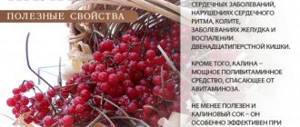The off-season has arrived again - a time of rampant viruses, bacteria and other infections, ready to attack the body of adults and children at any moment. The nasal passages are the first to enter the “battle”, stopping pathogenic microflora on the mucous membrane, of course, if the local immunity is able to overcome the pests.
The immune system of our citizens wants to be the best, and, unfortunately, viruses and bacteria often defeat the weakened microflora of the nasopharynx. A banal runny nose becomes more complicated, microbes join it, thick, hard-to-clear green snot appears, complete nasal congestion, and other delights of bacterial rhinitis.
It is for such cases that French scientists developed an antibacterial spray for local treatment of infectious (bacterial) runny nose - isofra. In this article we will look at the cheapest analogues of isofra and compare their effectiveness.
Scrolling through the forums, we can conclude that patients rarely turn to official instructions, but more often seek advice from discussion participants, or use search engines to try to find non-existent forms of isophra and its analogues. For example, the question is asked about where to buy isofra drops, what is their price? And the answer is simple - there are no isofra drops.
To select analogues for isofra, we will first study the brief instructions for the drug, on the basis of which an adequate review of analogues and their comparison will be made.
Contraindications
The drug is not used in cases of individual intolerance to framecitin sulfate, in which complaints of allergic reactions and gastrointestinal disorders may occur. The use of the drug is not recommended for more than 10 days, because the development of candidiasis of the nasal and pharyngeal mucosa is possible. Uncontrolled instillation leads to addiction and ineffectiveness of the product.
Isofra is contraindicated for children under one year of age , although there are certain studies that prove the safety of Isofra spray in early infancy, i.e. The drug can be used 30 days after birth. Many practicing ENT doctors, especially in hospitals, prescribe isofra for up to a year, because it is an excellent alternative to many systemic antibiotics.
There is no data on the use of isofra during pregnancy and breastfeeding, so the decision remains with the doctor.
Other foreign analogues
Imported analogues of isofra are represented by a large number of them; you can select the cheapest effective synonyms for the drug.
- Polydexa
. The best analogue of imported isofra with an antiseptic effect. The main substance phenylephrine sharply constricts blood vessels, making breathing easier. - Nazol
. The composition of the medicine contains phenylephrine hydrochloride. Suitable for the treatment of inflammation of the nasal cavity, including manifestations of an allergic nature. The drug should be taken with caution during pregnancy and lactation. - Otrivin
. The main substance oxylometazoline relieves swelling and nasal congestion. A relatively high-quality replacement for a cheap imported analogue. Used for various ENT diseases.It is prohibited to take during pregnancy, lactation, children under 6 years of age, during surgical interventions, allergies, atherosclerosis, atrophic rhinitis, tachycardia, hypertension. The average price is 100–150 rubles.
- Xymelin
. A cheap analogue of isofra with adrenomimetic action. Effective for the treatment of various rhinitis, sinusitis, acute respiratory infections, and operations in the nasal cavity.It has contraindications for diabetes, allergic reactions, atherosclerosis, atrophic rhinitis, children under 2.5 years old, during pregnancy and lactation. The average price is 85–100 rubles.
- Milistan
. Contains paracetamol and cytirizine. Relieves signs of inflammation and alleviates general condition. It is a multisystem drug, which indicates the high quality of the medicine.
In the final part of the article, I would like to summarize and say that choosing a high-quality and inexpensive analogue of isofra will not be difficult.
But it is worth remembering that, how and with what to replace this drug, regardless of the price, only a qualified doctor should! The specialist will select an effective synonym that will meet all the requirements and will not bring undesirable consequences. Be healthy!
- Related Posts
Isofra (spray) is an antibiotic from the group of aminoglycosides for topical use in otorhinolaryngology. The active ingredient is framycetin sulfate.
Highly active against:
- gram-positive microorganisms - Staphylococcus spp. (resistant to penicillins and other antibiotics), some strains of Streptococcus spp.;
- gram-negative microorganisms - Pseudomonas aeruginosa, Klebsiella spp., Enterobacter spp., Salmonella spp., Shigella spp., Proteus spp.
- Treponema spp., some strains of Streptococcus spp., anaerobic microorganisms are resistant.
Available in bottles as a nasal spray. Acts bactericidal. Active against gram-positive and gram-negative bacteria that cause the development of infectious processes in the upper respiratory tract.
When used externally, the active substance of Isofra spray is not absorbed into the systemic circulation.
Dosages
The course of injections with isofra spray is usually 5–10 days, on average it lasts 7 days.
Adult mode:
- one spray into each nostril up to six times a day.
For children:
- the dosage is half as much, i.e. one spray into each nostril up to three times daily.
The position of the bottle during use should be vertical.
How to treat a runny nose in a baby (review of the use of Isofra)
Isofra - list of cheap analogues
Isofra has no structural analogues, therefore, for an adequate replacement, you need to find a cheap or expensive drug that will be almost similar to the effect of the drug in question.
First of all, you need to remember that isofra is an antibiotic, so the search should begin with this pharmacological group, followed by antiseptics. If a drug is selected for children, then the primary criterion is not always to find cheaper analogues, because the cheapest drugs are unlikely to be able to replace an antibiotic of this class, and parents cannot wait to see a healthy child as soon as possible. Therefore, loved ones are willing to pay any price to treat young patients. When a drug is chosen for adults, the price will most likely take first place.
Let's make a list of isofra analogues and determine which ones are cheaper.
List of analogues:
- polydex (spray, 15 ml) – 320 rubles;
- sialor (protargol 2%, 10 ml) – 260 rubles, you can purchase protargol in prescription departments, price up to 100 rubles;
- chlorophyllipt oil 2% (20ml) – 145 rub.;
- collargol - prepared in the prescription departments of pharmacies, price up to 100–150 rubles;
- octenisept (solution, 50 ml) – 570 rubles;
- Bactroban (nasal ointment, mupirocin 2%) – 500–600 rubles;
- Okomistin (eye drops, 10 ml bottle) – 140 rubles (also used for the nose);
- miramistin (solution 0.01%, 50 ml) – 240 rubles;
- bioparox (aerosol, 10 ml) – 300 rubles.
Analyzing the prices for isofra analogues, we can conclude that only drugs related to antiseptics - protargol, collargol, miramistin, chlorophyllipt, okomistin - will be cheaper. Antibacterial analogues - bioparox, polydex are almost the same in price, sometimes there is only a slight difference, it is in the range of 30–50 rubles.
When choosing a remedy for bacterial rhinitis, the question arises: “Which drops will be more effective, what is better to prefer, for example, isofre or polydex?” Indeed, local antibacterial agents have their own characteristics, some consist of one antibiotic, others of several. So what should you choose?
Isofra + protargol = how dangerous is it all together??
Is he sometimes “zilch”? The ENT doctor makes the complex drops for us herself, but I have a recipe just in case. Find out, they have many pharmacies in the city. There is also a Pharmacy warehouse with delivery: 547-82-28, 542-45-72, 542-15-59 Isofra is an antibiotic, so if you just have a stuffy nose, then you probably shouldn’t use it. I bought Isofra freely at the pharmacy (30 UAH), Polydexa cannot be swallowed, the annotations warn of poisoning. Armed - ??? (mom couldn’t read the prescription accurately), isofra and said that if the temperature continues today (and this is already the 5th day) - an antibiotic should be given, because You can plant a heart in a child.
Firstly, we underwent a course of procedures at the hospital on Bogatyrskaya: an unpleasant but effective “cuckoo”, laser and inhalation (?), this was two years ago, I may be wrong in the name of the last procedure.
Examine the child.
And as often as possible: every half hour - hour!!! White and green need to be watched and observed.
I wouldn’t touch the current and transparent ones at all.
I really love this product myself! Use of materials in printed publications is possible only with the written permission of the editor. Copyright of articles is protected in accordance with the Copyright Law. Use of materials on the Internet is possible only with the indication of a hyperlink to the portal open for indexing. Isofra - yes, 31 and a few kopecks - ended up buying her too (since she is more “for children”).
Petrovka is in transition!!!
Their help desk: 518-53-58, 518-91-38, 518-60-85.
It was just good advice for you.
I know that Polydex is also prescribed, but we have not encountered it yet.
We bought it and tried it.
Also important:
- Carrello Quattro stroller - “How Carrello Quattro defeated Espiro Magic” After two weeks of use, we finally went to see the new Carrello Quattro. […]
- How many cubic meters of water do you use per month? Gentlemen! I looked at your answers and came to the conclusion that you are still spending freely […]
- Maternity hospital "Maternity hospital No. 18" in the city of St. Petersburg - reviews, services, addresses, official website - on babyOfficial information of the organization "Maternity hospital No. 18": website, doctors, directions to […]
Isofra or Polydex – which is better?
The antibacterial drugs in question are produced by one French manufacturer, are used to treat infectious rhinitis and sinusitis, and have almost the same price. The maximum course of taking isofra and polydex is 10 days. This is where their similarities end.
The main distinguishing feature is the composition . Isofra is a mono product consisting of only one active antibacterial substance - framecithin. Polydexa is a complex of two antibiotics (polymexin B sulfate and neomycin sulfate), as well as phenylephrine hydrochloride (adrenergic agonist) and dexamethasone sodium metasulfobenzoate (glucocorticoid).
This difference makes it possible to assert that Polydexa is therapeutically stronger, and in addition to eliminating bacteria, it is also capable of eliminating inflammation and all kinds of manifestations of allergic symptoms.
Parents often ask the doctor what is better than Polydex or Isofra for their child? The answer to this question depends, firstly, on the age of the child, and secondly, on the clinical manifestations. Isofra is prescribed after 12 months of life, and Polydex only starting from 2.5 years. If children are prone to allergies, Polydex will be the best. Although, for uncomplicated forms of bacterial rhinitis, it is still better to stick to mono drugs.
If a runny nose has just begun, green snot appears, but it comes out easily, it is better to start treatment with isofra. If it is ineffective, the drug is replaced with Polydex. It should be noted that for sinusitis, in most cases, Polydex is more effective.
Isofra is “lighter” in composition and has fewer side effects. If the picture of complicated rhinitis is clearly expressed, you will have to resort to a complex antibacterial spray - Polydex. These drugs are not saline solutions, and therefore require clear doctor’s recommendations.
Many patients are confused about the identity of these drugs, believing that there is no difference between them, and they are just antibiotics. Unfortunately, this opinion is not uncommon on forums, and the worst thing is when participants give incorrect advice to each other regarding any antibacterial drugs.
Unlike isofra, polydex is available in another form - in drops, and is used to treat otitis media.
Dr. Komarovsky to the question: “Which is better isofra or polydex?” answers as follows. He says that he is not a supporter of prescribing these remedies for green snot. The main reason for Komarovsky’s attitude towards the use of isofra, polydex and bioparox is skepticism regarding the benefits of these sprays.
According to Russian scientists, the drugs in question are able to completely cure green snot in 60% of patients on the fifth day. There is also information that Polydex and Isofra for adenoids in children after 7 days of use effectively relieves inflammation, which is confirmed by x-ray monitoring.
A complete comparison of isofra and polydex. Patient reviews.
Pharmacological properties and indications for use
The advantage of the drug over other antibiotics is its local effect. Substances act without being absorbed into the bloodstream and without being carried throughout the body. Thanks to this ability of the drug, the risk of side effects is minimized.
In the treatment of severe sinusitis, this remedy is used only as a component of complex treatment based on drugs that have a systemic effect.
Isofra nasal spray is prescribed to children and adults as a primary or secondary treatment for various diseases.
- Bacterial runny nose. The drug will help to quickly cope with an infection accompanied by symptoms such as nasal congestion, secretion of thick green mucus, and hyperthermia.
- Rhinopharyngitis. If a severe, prolonged runny nose is accompanied by a sore throat, and a white coating appears on the throat, Isofra spray is also prescribed.
- Sinusitis. The causative agents of this disease are pathogenic microorganisms. But in the first days the spray is not used, as it is ineffective in fighting viruses. It is advisable to use Isofra in case of purulent mucus discharge from the nose.
The drug has found application not only in the treatment of diseases in the active stage, but also in preventive procedures aimed at preventing infection. In particular, the use of a spray is important after surgery. The regimen for use in such a situation is determined individually, taking into account the patient’s condition. The use of an antibiotic drug will help prevent an infection that can rapidly develop as a result of the penetration of bacteria into the damaged mucosa.
Isofra or rhinofluimucil - which is better?
The similarity of these products lies only in the fact that they are produced in the form of sprays and are used to treat a runny nose. What to prefer - rhinofluimucil or isofru - is up to the doctor to decide, because The presented products belong to different pharmacological groups and have different compositions. The manufacturers of the products are different, Isofra is made in France, Rinofluimucil is made in Italy.
In principle, they cannot be called analogues, because rinofluimucil does not replicate either the composition of isophra or the mechanism of action. If we call rhinofluimucil an analogue, then only as a nasal remedy for the common cold.
Rinofluimucil has a vasoconstrictor (decongestant) and mucolytic effect (thin the mucus). The main active ingredients are tuaminoheptane sulfate-acetylcysteine and acetylcysteine. The drug is prescribed for rhinitis of various etiologies, which is a significant difference from isophra.
Isofra is a pure antibiotic (framycetin) that eliminates bacteria. For other types of rhinitis, the remedy is ineffective and can be harmful.
As for contraindications, rinofluimucil has more of them. The permissible age for both drugs is from 12 months of a child’s life. Although for rinofluimucil, the instructions include a disclaimer that the drug should be used with caution for up to three years. In practice, this remedy has been used for years under the supervision of a doctor.
Comparing prices, we can say the following: rinofluimucil is about 30–50 rubles cheaper. The average price in Russian pharmacies is 260 rubles.
Instructions for use of Rinofluimucil.
General qualities
Having been used for the treatment of otolaryngological diseases for a long time, drugs against inflammation of the nasopharynx have some similar features:
- As a result of treatment, the consequences of nasal infections are eliminated, and chronic forms of runny nose cease to cause inconvenience.
- They are used for complicated forms of the disease, as part of complex therapy as prescribed by the attending physician.
- As aids, they are used to treat adenoids in children.
- The average duration of treatment is a week.
- Allergic reactions to the active elements of drugs are extremely unlikely and occur due to individual intolerance.
Isofra or bioparox – what to choose?
The drugs are not structural analogues, but belong to the same pharmacological group - antibiotics for topical use. The main task of these products is to fight microbes and eliminate inflammation in the area of use.
The active ingredient of bioparox is fusafungin, and that of isofra is framecithin sulfate.
Bioparox is used not only for the treatment of bacterial rhinitis, but is also widely used for diseases such as laryngitis, pharyngitis, tonsillitis, rhinopharyngitis. The drug contains an additional nozzle that allows injections through the mouth.
Unlike isofra, bioparox is prescribed only from 2.5 years of age , because there is a possibility of laryngospasm. Bioparox is also prescribed with caution for allergy sufferers prone to bronchospasms. Bioparox is more likely to cause various side effects.
The price for isofra and bioparox is almost the same, minor fluctuations up to 50 rubles are possible.
Instructions for use of bioparox. An article about bioparox analogues.
How to treat runny nose and sinusitis in children
About the drug
Isofra is an antibacterial drug for topical use in otorhinolaryngology, available in the form of a nasal spray. 10 ml of the drug contains 125 mg of framycetin. This active substance belongs to the group of antibiotics - aminoglycosides and has a bactericidal effect on pathogens of inflammatory processes in the upper respiratory tract, namely, it inhibits the activity of:
- gram-positive bacteria – staphylococci, including those resistant to the penicillin group;
- gram-negative microbes - Escherichia coli and Pseudomonas aeruginosa, Proteus, Klebsiella, Salmonella and others.
However, framycetin has no effect on some strains of streptococcus, anaerobic flora, and treponema.
Like any antibacterial agent, Isofra spray is not recommended for self-treatment; it can only be used after a doctor’s prescription.
This is due to the fact that the local antibiotic acts only at the site of inflammation and cannot create the optimal concentration of the active substance in the bloodstream necessary to completely destroy the pathogen. Therefore, uncontrolled use of such drugs can contribute to the development of microbial resistance to the antibiotic or provoke the development of allergies.
It will also be interesting: Treatment with Ceftriaxone for sinusitis: patient reviews
